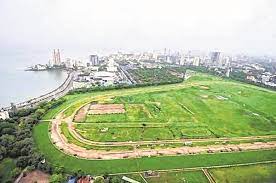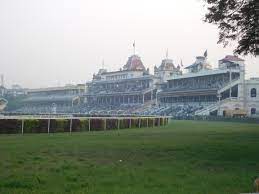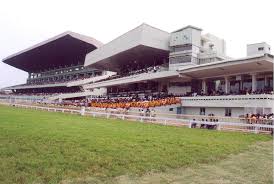 The Mahalaxmi Race Course
The Mahalaxmi Race Course
The Commercial Hub of India is blessed with Mahalaxmi Race Course and the club is modelled on the lines of Melbourne Race Course, Australia the club came into existence in the year 1883.
Facing the sea is awesome nature for this club. The land of 225 acres was originally donated by Sir Cusrow N Wadia, Now on perpetual lease from the MCGM.
The Club hosts racing at two race courses, one at the Mahalaxmi Race Course, and at Pune. The racing commences here in second half of November every year for jumbo season of 5 and a half months ceasing to a halt in the end of April the following year and season at Pune from July to October in all about 70 racing days in a year.
The oval-shaped 2400-metre Mahalaxmi Race Track, rated one of the best in Asia, has an even surface and a 600 metre straight stretch which accounts for a surprise winner emerging from the middle or back punch bringing utmost thrills in this game.
There is also a straight chute that allows races up to 1600 metres to be run with only the home run. The race course was originally built under the direction and supervision of Major JE Hughes around 1883.
This race course is a Home to the 5 Indian Classics including stellar event Indian Derby on the first Sunday of February every year.
A designated heritage structure is the Grand Stand of this club is a feast to everyone’s eyes
The club has done everything to facilitate fair and clean racing and to weed out human error as well as malpractice such as importing automated starting stalls, installation of digital photo-finish cameras, split-second electronic timers and close-circuit television systems to watch the action on the track from more than one angle have been installed at both the race courses..
Like other major centres Computerized Tote betting avoids delay in disbursal of dividends.
The Club permits Amateur Riders’ Club to conduct d Gymkhana Races after the end of the Mumbai season as well as polo matches in the polo season.
Contributors of a Social Cause:
The Club maintains the elegant public garden in the centre of the Mahalaxmi Race Course and also the recently upgraded walking/jogging track for free public use. The much appreciated facility is used by hundreds of citizens every day of the year
The Commercial Angle:
RWITC rents out its lawns with associated facilities for weddings and other outdoor events such as fashion shows, musical evenings and the like. Though charged it is considered to be one of the most prestigious venues in the city.
Some Interesting Facts about Royal Calcutta Turf Club
An Article by Punters’ Mind
 THE HISTORY
THE HISTORY
The organised racing in India began at Royal Calcutta Turf club. The first race meetings held here prior to 1795 though Madras Race Club has official record of conducting races from 1795 exists, but unfortunately Kolkata race club does not have the record.
At first, races were held in the suburbs at Akra in the Garden Reach area where, at that time, the king of Oudh, deposed by the British, and his descendents lived in their palatial garden houses.
Racing in Calcutta came to an abrupt, but temporary halt in 1798 for political reasons and it was only after five years later resumed by Bengal Jockey Club.In 1809, the venue was shifted from Akra to the Maidan area which is now virtually the centre of the city and there it remains until today.
In the days of the Bengal Jockey Club race meeting was held in the mornings. The club was a highly organised institution and was constantly in touch with racing affairs in England. Indeed, results of Calcutta races were regularly published in the public press in London in those days.
How Dead Heat Terminology Originated?
Races, in those days, were generally over two and three miles and not in sprints. In the Bengal Cup racing event in 1845, the grey horse Arab Crab and the bay Arab Oranmore raced five heats carrying 55 kg each over two miles. As the judge could not separate the contestants in two of the five heats, those heats were considered “dead” and that presumably is how the expression began.
In the year 1812, the new course was laid out in Calcutta very near to current location and now moved to this major centre. Calcutta Turf Club was officially born in 1847. Its important roles were those of regulating all matters concerning racing and protecting the interests of the turf in Calcutta.
Rs 5 Crores Stake Money to Derby Winner
Other than in Western India, within forty years Calcutta Turf Club became the administrator of the sport throughout the country. It is also the first centre in the subcontinent to stage a Derby race named the Calcutta Derby Stakes, in 1842, was confined to maiden Arabs over a distance of 3200 meters and carried the then fabulous prize of Rs 5000/- for the winner which is equivalent to roughly Rs 5 crores in today’s currency value. In 1856it was replaced by Viceroy’s cup. Nero was the first winner over the St. Leger distance. Two years later, the race was won by an Indian bred mare, a feat repeated after 105 years, an Indian filly, Hovercraft, won in 1964. By then this race was again renamed as Queen Elizabeth II Cup.
The revision of the Weight-for-Age Scale came into functioning after 1860, and a tote was introduced in 1872, the first Monsoon Meeting took place in Calcutta in 1879
By 1880 the racing shifted to afternoons and new stands were built- the present imposing stands came later. It was from that year, the beginning of the general public’s growing interest in racing as a spectator sport.
The complete upgrading of Rules of Racing in 1897 with new important rules added that no Turf clubs in India is allowed to race under Rules without being controlled by either of the two Turf Authorities Mumbai and Calcutta. The new rules banning of jockeys from betting and the appointment of a professional handicapper happened then
By this time, the stature of the Calcutta Turf Club had grown extremely high. By1889, its jurisdiction extended to all the courses of India excepting Bombay, Poona, Karachi and Khelapur which raced under Bombay, and there were as many as 52 courses in India (and Burma) at that time.
Why Royal was added to Club’s title?
The use of the first timing device on the Course started in 1907, the construction of the existing Monsoon track by the club in 1910. This is the unique track perhaps the only one of its kind in the world-in that by some ingenious device, it is the quickest draining tracks that one could imagine. At the same time, the Rand-wick rails were fitted on the track. This type of rail is now universally used but that time early nineteen hundreds, it was an innovation.
`Royal’ was prefixed to the title of the Club in 1912, following King George V’s second visit to the Calcutta Races.
The extensive Stands of the Calcutta Race Course, white amidst lush green open space, have a special charm. Away on the horizon are the high-rise city buildings and nearer, the white marble grandeur of the Victoria Memorial in its well planted park.
Calcutta at one time exercised racing control and rules of racing over 73 racing centres in the sub-continent extending between Peshawar and Mandalay.
Hyderabad Race Club,Telengana India India
HRC Paddock ring
This is one of the most profitable Race club in India and the racing standards are comparable to international standards. Recent Victory of Grade 1 races at the Bangalore current season brought some added focus to this racing centre. The quality of this racing horses have vastly improved.
Keeping the track in excellent condition, HRC plans to introduce a new revamped betting terminals and kiosks, introduction of ticket vending machines that are punter friendly, additional new pools, and many more good news to racing patrons.
Soon punters can sit at their seats to get tote tickets! No hassles to run around the counters or stand in a long queue. Yes, hand held machines with the ticket issuing professional will be around you for the asking. A marvellous concept, first time to be introduced at HRC.This thought will be put into action very soon
Not only that there will be automating ticket vending machines that you can print your own tickets. Sounds incredible? HRC is spending around 70 million Rupees on the up gradation of the existing systems. Number of ticket issuing terminals will go up to 2048 from the present 750 and a big new off course terminal complex coming up at Vijayawada, an another commercial hub in the state are the goodies to the race punters. Payout will be much faster, Delhi Inter venue betting will be added from coming season are the latest hopes to the punters to get realized soon.
Well, there are some good news to Jockeys owners and trainers too. In the official website Jockeys owners and trainers can access their accounts; Trainers will have access for their wards in the new two horse walkers at a pre determined speed level to keep the animals fit. A new electronic weighing scale to give the accurate horses weight is also procured.
There will be a total of 22 ‘A’ licensed trainers with 763 horses in their charge .Among them are 211 two-year-olds, 43 jockeys, eight apprentices among them, with professionals from other centre expected to add color to the competition.
The total purse amount is Rs 8.5 crores around last years with a marginal increase just 5 lakhs only
Added purse of 3 million(Sponsored by the Vijay Textiles is on Deccan derby and 2 millions on President of India gold Cup and the chief events in this centre this season


